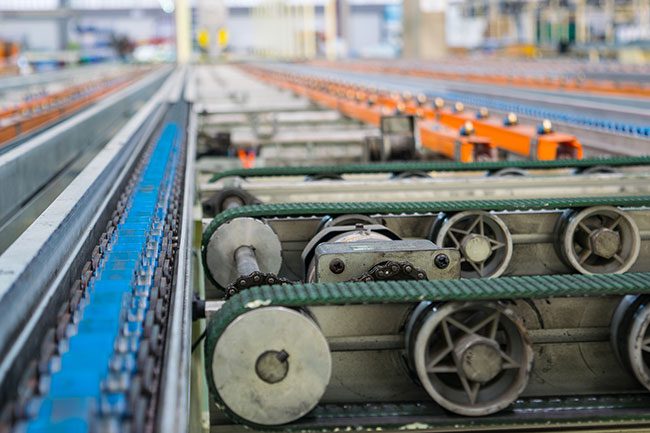Conveyor Systems Stretch the Limits of What’s Possible

Conveyor systems offer organizations versatility in environments and logistical scenarios where other machines could not hope to fulfill a similar role. Leveraged properly, the humble conveyor can transform the way your business manages logistics and transportation in difficult situations, greatly enhancing efficiency and efficacy.
When are conveyor systems appropriate?
Conveyor systems can operate consistently in locations other machines may not. While other solutions may work for a time under less ideal environments, the relative cost in terms of downtime, maintenance, replacements, and other failures quickly renders the reliability of a conveyor system the superior choice.
Extreme heat. In high-heat environments, friction, lubrication, and precision all become much more challenging to control than in a standard environment. Many materials experience warping under extreme temperature, and nearly all materials will experience more rapid wear under such a scenario.
Conveyors minimize these problems admirably compared to more complex mechanical solutions, and allow for more cost-efficient installation and upkeep in scenarios where more expensive, sturdy materials are mandatory.
Tight places. A well-designed conveyor system takes up the bare minimum of space for transporting a particular material or good, while being robust enough to require a minimum of maintenance—a must, for areas where access is difficult to begin with.
Poor ventilation. Poor ventilation greatly increases the wear on many systems, making a robust system such as a conveyor system absolutely mandatory for effective operations under such an environment.
In addition, each of these problems also makes it nearly impossible to practically maneuver materials without the use of some form of machinery or equipment—extreme heat, poor ventilation, and limited space alone or combined make it impossible or at the very least highly impractical for employees to physically move materials.
Targeting Specific Challenges with Conveyors
Conveyor systems are best utilized to tackle specific impediments or combinations of impediments for moving materials. If you find yourself struggling to manage the transportation of materials due to any of the following, a conveyor system could be your best solution:
Environmental. The aforementioned environmental concerns are an obvious reason to adopt a conveyor system, but they can also be built to tackle any number of obnoxious, difficult, or awkward environments with ease.
Something as mundane as using a conveyor system to move people or cargo along rough or hilly terrain can massively improve worker efficiency.
Hazardous. In scenarios where people can’t easily or safely work, conveyor systems are an excellent way to shuttle materials. This is doubly beneficial in many cases, as the same conditions which are hazardous to humans are often quite caustic to machinery, increasing wear and tear on less robust equipment.
Logistical. In many situations, a conveyor system doesn’t tackle a particular challenge of the environment—it simply makes it easier to move materials from point A to point B efficiently. Combining a conveyor system with various automated logistics systems can work wonders.
Leveraging conveyor systems for mundane logistics can minimize breakage, reduce worker injuries, and enhance the work efficiency of your logistics team with minimal difficulty.
Scenarios Benefiting from Conveyors
Essentially, the simple efficiency of the conveyor system makes it viable in nearly any circumstance; while you could develop an over-engineered solution to any specific problem, you could throw a basic conveyor system at any set of extreme and unusual circumstances and immediately return to productivity. Conveyor systems get work completed where alternatives fail. For example, conveyor systems are frequently used to deal with the difficulties of:
Mine shafts. Given the challenges of ventilation, space, and sheer distance involved in many mine shafts, a conveyor system is frequently the only viable transportation solution. Smaller transportation vehicles and machines can play a role in certain mine shafts—in certain large shafts, even large trucks are used–but conveyor systems offer the greatest versatility and safety in the widest range of mine shaft scenarios.
They don’t require clean air, don’t generate more noxious gases to remove, don’t require a person to traverse the entirety of the transport path, etc. You can use them to produce far more efficient materials-only passages parallel to the routes people travel.
Foundries. Extreme temperatures, hazardous environments and materials, and poor ventilation combine to make foundries one of the few work environments of comparable danger and difficulty to a mine shaft.
Leveraging simple conveyor systems to move materials through dangerous areas of the foundry greatly minimizes the danger to employees and streamlines work. Forklifts and other machinery simply wouldn’t be safe in such an environment, even if carefully managed.
As you can see, a conveyor offers flexibility through basic rugged simplicity; the systems involved can be built sturdily and simply, allowing easy installation, use, and upkeep in even the most hazardous of environments and difficult of usage scenarios. To find out more about the use of conveyor systems, contact us today. Contact us today for more detailed information on conveyorsystems and how it can meet the needs of your business

